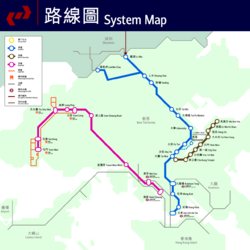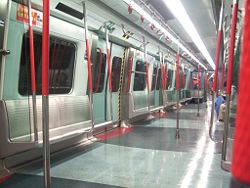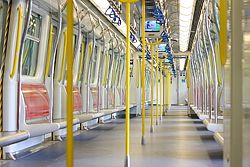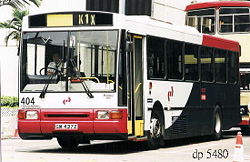Kowloon-Canton Railway
| Kowloon-Canton Railway (KCR) | |
| Info | |
|---|---|
| Locale | Hong Kong |
| Transit type |
|
| Number of lines | 4 (3 railway lines, 1 light rail system) |
| Number of stations | 33 railway stations, 68 light rail stations |
| Daily ridership | about 1.49 million (2006) |
| Operation | |
| Began operation | October 10 1911 - December 2 2007 (operation taken over by MTRCL) |
| Operator(s) | MTR Corporation Limited |
| Technical | |
| System length | 120.5 km (75 mi) |
| Track gauge | 1,435 mm (4 ft 8½ in) (standard gauge) |
The Kowloon-Canton Railway (KCR; Traditional Chinese: 九廣鐵路) refers to a railway network in Hong Kong[1] which is now combined with The MTR Railway system, comprising rapid transit services, a light rail system and feeder bus routes within Hong Kong, and intercity passenger and freight train services to the rest of China. Since 2 December 2007, the network has been operated by the MTR Corporation Limited under a 50-year service concession, which is extendable. Ownership has continued to be held by its previous operator, the government-owned Kowloon-Canton Railway Corporation. In 2006, the local KCR passenger train network (i.e. intercity services excluded) recorded an annual ridership of 544 million.
Before the rebranding in 1996, "Kowloon-Canton Railway" or "KCR" referred to the railway that runs between Kowloon in Hong Kong and the city of Canton (now Guangzhou) in mainland China. When Hong Kong was under British rule, the section of this railway that lies within the territory of Hong Kong was known as the "British Section", which largely corresponded to the present-day East Rail Line. The Chinese Section of the original Kowloon-Canton Railway in mainland China is called the Guangshen Railway.
Contents |
History
The original Kowloon-Canton Railway was opened in 1911 as a rail link between Kowloon in Hong Kong, then a British crown colony, and the Chinese city of Canton (now Guangzhou).[2] The founding member of the former KCR network, the British Section of the Kowloon-Canton Railway, was opened in 1910. Trains were steam-hauled. From the one line railroad, the KCR network was expanded to 3 railway lines and a light railway system, with 32 railway stations and 68 light rail stations.
In the past few years the subject of invasive marketing has arisen with the advent of television screens on carriages. The first few weeks saw several hundred complaints as the volume level was turned up to maximum in order to help generate revenue from marketing. After several weeks of complaints the company eventually backed down and introduced two 'quiet cars' to the rolling stock offering a peaceful respite for passengers. Other complaints included window advertising which blocked the views outside and made some passengers travel sick. Although windows continue to be obscured making viewing of the exterior difficult and travel less comfortable for passengers, the company has responded to complaints by reducing the size of the advertisements.
Service commenced
Opened in 1910 as a single-track system, the British Section of the original Kowloon-Canton Railway (roughly corresponds to the present-day East Rail Line). With the Chinese section opened in 1911, through-trains ran from the southern terminus in Tsim Sha Tsui across the border to the southern Chinese city of Canton (now Guangzhou).
At first trains on the British Section ran northwards from a temporary terminus at Kowloon Point through the eastern New Territories up to the border with China at Lo Wu. The permanent southern terminus, Kowloon Station in Tsim Sha Tsui, opened slightly later in 1914.
A narrow gauge railway operating works trains was used in the construction of the standard gauge British Section. The narrow gauge materials were later used to build the now-defunct Sha Tau Kok Railway. After the communist takeover in mainland China in 1949, through-trains were no longer able to cross the border until the service was resumed in 1979.
An expanding network




The British Section of the original Kowloon-Canton Railway was originally operated by a department within the Hong Kong Government. Following the government's plan to corporatise the operation of the railway, the Kowloon-Canton Railway Corporation (KCRC) was established in December 1982, with the government remains as the sole shareholder.
With the development and urbanisation of the New Territories, the British Section has become an important corridor to connect the new towns in eastern New Territories with urban Kowloon. Electrification and conversion to a dual-track system was completed in 1984. Since then, the suburban rail has become much more metro-like. Frequent service is provided, and in the 1990s trains were refurbished to provide less seats and more standing places.
In 1984, the KCRC accepted the government's invitation to build and operate a light rail system in northwestern New Territories. The Light Rail Transit (known later as the KCR Light Rail, and now simply the Light Rail) was opened in 1988.
The KCRC won a bid in 1996 to build a "Western Corridor Railway", later branded as the KCR West Rail and opened in 2003. The British Section of the original Kowloon-Canton Railway was renamed KCR East Rail, and the LRT became KCR Light Rail. The names "Kowloon-Canton Railway" or "KCR" has become to refer to the network operated by the KCRC. The KCR Ma On Shan Rail was opened in 2004 as a branch line to the KCR East Rail.
Takeover by MTRCL
Various proposals to merge the KCRC and the other railway operator in the territory, the MTR Corporation Limited (MTRCL) has been on government's agenda since the 2000s. In 2006, the government, as the sole shareholder of the KCRC, decided that the two railway networks should be merged with the MTRCL being granted a service concession to operate the KCR network for an initial period of 50 years. The decision was passed by the Executive Council on 11 April 2006, and was later approved by the Legislative Council and the minority shareholders of the MTRCL [3] (the government, which had a 75% stake in the MTRCL, did not vote).
It was later decided that the merging of the corporations' two rail networks would take place on December 2, 2007. Since then the KCRC has become a holding company. Under the service concession, the MTRCL pays the KCRC a fixed annual sum of HK$750 million, and from the fourth year after merger of the two networks, a sliding percentage scale share of annual revenue above HK$2.5 billion earned from the KCRC network.
As part of the merger, the KCR East Rail, KCR West Rail and KCR Ma On Shan Rail were renamed East Rail Line, West Rail Line and Ma On Shan Line. The KCR Light Rail is known simply as the Light Rail. Mong Kok Station on the East Rail was renamed Mong Kok East Station.
Express Rail Link proposal
On 2 August 2007, Chief Executive Donald Tsang announced that, considering the technical requirements, passenger forecast, Hong Kong's future economic development and the closer trade ties between Hong Kong and Guangdong, the new Guangzhou-Shenzhen-Hong Kong Express Rail Link will adopt the dedicated-corridor option after the 10th Plenary of the Hong Kong/Guangdong Co-operation Joint Conference. The Kowloon-Canton Railway Corporation has submitted a detailed project proposal to the government.[1] Because of the merger, however, it is unlikely the Rail Link will be built and operated by the KCRC.
Rolling stocks
Locomotives
| Manufacturer | Model | Type | Numbers | Year |
|---|---|---|---|---|
| General Motors (Australia) | G26 CU diesel loco | 3 | diesel locomotives | (1974-1977) |
| Siemens (Germany) | ER20 locomotive | 5 | diesel locomotives | 2002 |
| Adtranz-SLM | Lok 2000 locomotive | 2 | electric locomotives | 1997 |
Passenger train coaches
| Manufacturer | Model | Numbers | Year enter service | Notes |
|---|---|---|---|---|
| Metro-Cammell | EMU England | 348 out of 351 cars (all underwent mid-life refurbishment between 1996 - 1999) |
1983 | |
| Kinki Sharyo | EMU SP1900 | 96 cars |
2001 | East Rail service |
| Itochu/Kinki Sharyo/Kawasaki Heavy Industries consortium | EMU SP1900 | 154 cars (2001) |
2003 | West Rail service |
| Kinki Sharyo | EMU SP1950 | 72 cars (same model as SP1900) |
2004 | Ma On Shan Rail |
| Kinki Sharyo | KTT passenger coaches | 12 | 1998 | for service between Guangzhou and Kowloon)4 |
Light Rail
| Manufacturer | Model | Numbers | Year enter service | Notes |
|---|---|---|---|---|
| Comeng (Australia) | LRV | 70 units | 1988 | |
| Kawasaki Heavy Industries (Japan) | LRV (DT/MT) | 30 units | 1992-1993 | |
| A. Goninan (Australia) | LRV | 20 units | 1997-1998 | |
| N/A | ballast car | N/A | N/A |
Feeder Buses
| Manufacturer/Model | Numbers | Year entered service |
|---|---|---|
| Leyland Olympian (UK) | 24 | 1990-1991 |
| Volvo B10M (Sweden) | 15 | 1995 |
| Dennis Dart (UK) | 3 | 1995 |
| Dennis Trident (UK) | 22 | 1999 |
| Mitsubishi Fuso MK117J (Japan) | 11 | 1991 |
| Volvo Olympian | 15 | 1997-1998 |
| MCW Metrobus Mk. II | 39 | 1987-1989 |
| MCW Metrobus Mk. I | 20 | 1988-1989 |
| Toyota Coaster | 12 | 1988 |
Service Vehicles
| Manufacturer | Model | Numbers | Year enter service | Notes |
|---|---|---|---|---|
| small crane car | ||||
| flatcars | ||||
| 25t crane | ||||
| crane with services wagon | ||||
| services Wagon | ||||
| Plasser and Theurer | track machine | |||
| maintenance wagon | ||||
| Overhead cable inspection vehicle | ||||
| Plasser & Theurer. Bauart 08-275 | Unimat 3S | |||
| Railbus | ||||
| JMY450B diesel loco |
²This steam engine was once used on the Sha Tau Kok Branch Line, but since its closing in 1924, the engine has been displayed in the Tai Po Railway Museum. It has been the only steam engine in Hong Kong for over 40 years (since the KCR last used a steam engine).
³Unit E44 (cars 144-244-444) didn't undergo refurbishment, and #144 is now kept at the Tai Po Railway Museum for display.
4All Kinki Sharyo stock are purchased and imported from Japan.
Historic
Some of these are located at the Hong Kong Railway Museum in Tai Po, but most were scrapped when the KCR changed to modern rolling stock in the 1970s:
| Manufacturer | Model | Numbers | Service years | Notes |
|---|---|---|---|---|
| First Class Passenger Carriage | 1960s | |||
| Hand Cart | ||||
| Motorized rail car | ||||
| Leeds Forge Co., Ltd. of Leeds, Yorkshire | First Class Dining Carriage | |||
| 65 tons breakdown crane car | ||||
| Hall-Scott | Petrol motor coaches (USA) | 2 | 1920s | renamed Taipo Belle and Canton Belle |
| Kitson | 4-6-4 Tank Engine | 1924 | ||
| Kitson | 4-6-0 Passenger Locomotive | 1930 | ||
| Robert Stephenson and Hawthorns | 260 Tank Engine | 1940s | ||
| 1st Class lounge & observation cars | ||||
| Ex-War Department) 2-8-0 | steam tenders | 9 | 1946 | |
| W.G. Bagnall | engines | |||
| Clyde Engineering (Australia) | EMD G12 diesel locomotives | 5 | 1954-1957 | |
| Clyde Engineering (Australia) | EMD G16 diesel locomotives | 4 | 1961-1966 | |
| W.G. Bagnall | 0-4-4T (UK) steam locomotive | 2 | 1924 | |
| Class 1 2-6-4T steam locomotive | ||||
| Class 3 2-6-4T steam locomotive | ||||
| Class 9 4-6-4T steam locomotive | ||||
| Class 15 4-6-0T steam locomotive | ||||
| Class 21 2-8-0 steam locomotive | ||||
| - | third-class open-verandah coach | 1911 | ||
| - | First-class coach | 1964 | ||
| Luggage compartment coach | 1955 | |||
| Kinki Sharyo | ordinary class coach | 1974 | ||
| Kinki Sharyo | third-class coach | 1974 | ||
| Engineering coach | 1921 |
Facilities
- Shatin Freight Yard
- Hung Hom Freight Freight Terminus/Yard
- Kowloon Freight Yard
- Mongkok Freight Yard
- Lo Wu Freight and Marshalling Yard
- Ho Man Tin Freight Terminal
- Sheung Shui Slaughter House
- Pat Heung Depot
- Tai Wai Maintenance Centre
- Ho Tung Lau Depot
- Fo Tan Goodsyard
Tunnels
The KCR line runs under two tunnels:
- Beacon Hill Tunnel - East Rail Line
- Tai Lam Tunnel - West Rail Line
See also
- Hong Kong Railway Museum
- MTR
- List of areas of Hong Kong
- List of MTR stations
- List of rapid transit systems
- Transport in Hong Kong
References
Government Documents
- Kowloon Southern Link (PDF) Papers of Subcommittee on matters relating to railways, Legislative Council. 7 January 2005. Retrieved 28 February 2005.
Other websites
- History of KCR East Rail
- KCR East Rail Rolling Stock
- KCR West Rail Rolling Stock
- KCR LRV Rolling Stock
- Notes
- ↑ Legislative Council information paper CB(1)357/07-08(01), THB(T) CR 8/986/00
- ↑ The remaining section, i.e., the Chinese Section, corresponds to the present-day Guangzhou-Shenzhen Section of the Guangshen Railway Corporation (Simplified Chinese: 广深铁路).
- ↑ Dan, Liu, editor; Xinhua (April 11 2006). "HK railway merger proposal gets green light". Retrieved on April 11, 2006.